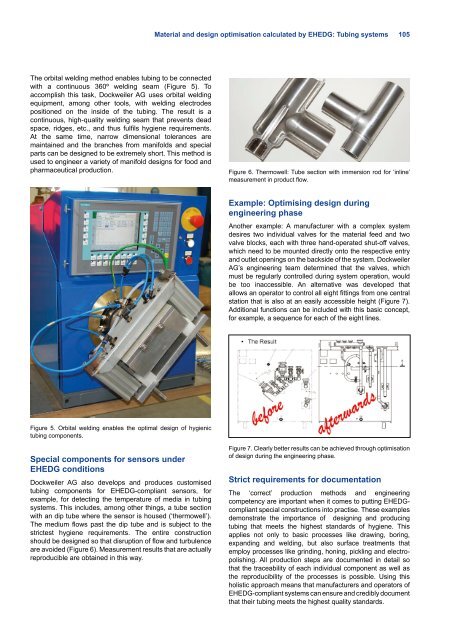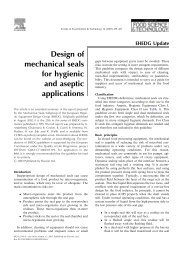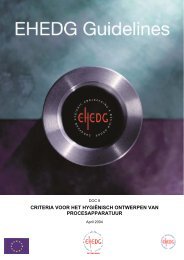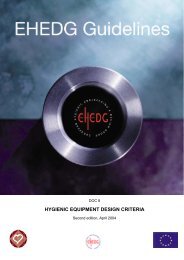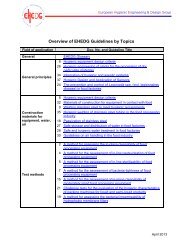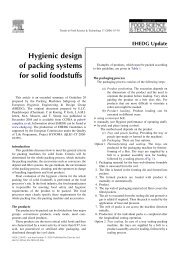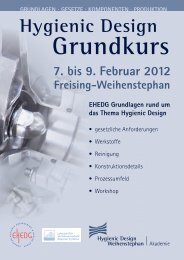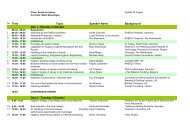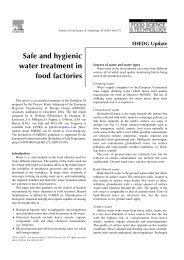Yearbook 2013/2014 - ehedg
Yearbook 2013/2014 - ehedg
Yearbook 2013/2014 - ehedg
Create successful ePaper yourself
Turn your PDF publications into a flip-book with our unique Google optimized e-Paper software.
Material and design optimisation calculated by EHEDG: Tubing systems 105<br />
The orbital welding method enables tubing to be connected<br />
with a continuous 360º welding seam (Figure 5). To<br />
accomplish this task, Dockweiler AG uses orbital welding<br />
equipment, among other tools, with welding electrodes<br />
positioned on the inside of the tubing. The result is a<br />
continuous, high-quality welding seam that prevents dead<br />
space, ridges, etc., and thus fulfils hygiene requirements.<br />
At the same time, narrow dimensional tolerances are<br />
maintained and the branches from manifolds and special<br />
parts can be designed to be extremely short. This method is<br />
used to engineer a variety of manifold designs for food and<br />
pharmaceutical production.<br />
Figure 6. Thermowell: Tube section with immersion rod for ‘inline’<br />
measurement in product flow.<br />
Example: Optimising design during<br />
engineering phase<br />
Another example: A manufacturer with a complex system<br />
desires two individual valves for the material feed and two<br />
valve blocks, each with three hand-operated shut-off valves,<br />
which need to be mounted directly onto the respective entry<br />
and outlet openings on the backside of the system. Dockweiler<br />
AG’s engineering team determined that the valves, which<br />
must be regularly controlled during system operation, would<br />
be too inaccessible. An alternative was developed that<br />
allows an operator to control all eight fittings from one central<br />
station that is also at an easily accessible height (Figure 7).<br />
Additional functions can be included with this basic concept,<br />
for example, a sequence for each of the eight lines.<br />
Figure 5. Orbital welding enables the optimal design of hygienic<br />
tubing components.<br />
Special components for sensors under<br />
EHEDG conditions<br />
Dockweiler AG also develops and produces customised<br />
tubing components for EHEDG-compliant sensors, for<br />
example, for detecting the temperature of media in tubing<br />
systems. This includes, among other things, a tube section<br />
with an dip tube where the sensor is housed (‘thermowell’).<br />
The medium flows past the dip tube and is subject to the<br />
strictest hygiene requirements. The entire construction<br />
should be designed so that disruption of flow and turbulence<br />
are avoided (Figure 6). Measurement results that are actually<br />
reproducible are obtained in this way.<br />
Figure 7. Clearly better results can be achieved through optimisation<br />
of design during the engineering phase.<br />
Strict requirements for documentation<br />
The ‘correct’ production methods and engineering<br />
competency are important when it comes to putting EHEDGcompliant<br />
special constructions into practise. These examples<br />
demonstrate the importance of designing and producing<br />
tubing that meets the highest standards of hygiene. This<br />
applies not only to basic processes like drawing, boring,<br />
expanding and welding, but also surface treatments that<br />
employ processes like grinding, honing, pickling and electropolishing.<br />
All production steps are documented in detail so<br />
that the traceability of each individual component as well as<br />
the reproducibility of the processes is possible. Using this<br />
holistic approach means that manufacturers and operators of<br />
EHEDG-compliant systems can ensure and credibly document<br />
that their tubing meets the highest quality standards.


